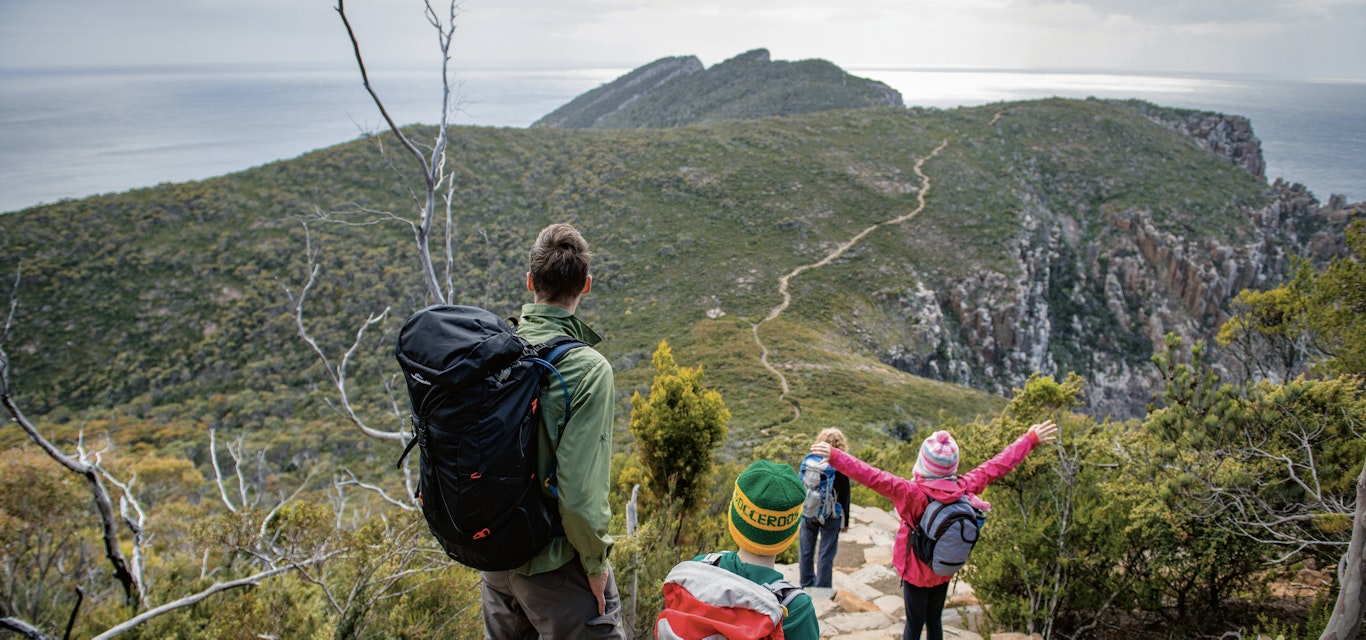The perfect pitch
With so much natural beauty to experience in the island state, there’s no better place to plan a down-to-earth camping holiday, with or without frills.
South: Tasman National Park & Bruny Island
On the Tasman Peninsula about 1.5 hours from Hobart, Tasman National Park features spectacular elevated views, towering dolerite cliffs and tall-tree forests that meet the sea. It also includes one of Tasmania’s most popular and family friendly campsites at Fortescue Bay, with a famous multi-day walk to boot. The Fortescue Bay Camping Ground is an excellent base for adventure activities, such as scuba diving and rock climbing, but has enough soft white sand to relax on if you feel like doing nothing at all.
If you’re thinking of heading south, then South Bruny National Park on Bruny Island has some idyllic camping options. Cloudy Bay is perfectly located for surfers thanks to its proximity to the waves. Jetty Beach is family friendly, with a curving sandy beach which offers safe swimming, snorkelling, kayaking and fishing. The Neck sits outside national park boundaries in a sheltered area behind sand dunes at the south of the isthmus.
North coast: Narawntapu National Park
An easy drive from Devonport and Launceston, Narawntapu National Park offers abundant wildlife, open plains, long, sweeping beaches and wonderful walks through a variety of ecosystems including coastal heathlands and grasslands, wetlands and dry sclerophyll forests. Named by the Tasmanian Aboriginal people after the West Head and Badger Head promontories that sit within the park’s boundaries, Narawntapu is rich in natural and cultural heritage. Protected shell middens and artefacts reveal the Tasmanian palawa’s way of life for thousands of years.
Take a day walk to Archers Knob for the best views in the park or lay your towel on Bakers Beach and swim in the cool and calming waters. You can even bring your horse with you (permit required). Narawntapu National Park is considered to be one of the best spots to camp in Tassie, with four campsites to choose from. The main campsite is at Springlawn, which has powered sites for caravans, campervans and camper trailers. It also offers the best facilities and is wheelchair accessible. Further afield, Bakers Point offers unpowered sites for camping and caravans, while Koybaa and The Horse Yards are tent-only sites with more basic facilities.
East coast: Spring Bay Mill & Maria Island
Spring Bay Mill makes it easy to settle into your camp-style stay. Located on the site of a former woodchip mill, Spring Bay Mill has been reinvented as an eco-resort and events space which has to be seen to be believed. Its ‘Glamping Field’ forms a quaint village of lotus-shaped canvas tents set among a light eucalyptus forest. The facilities are next level, including an impressive communal camp kitchen, complete with fire pit, and excellent toilet and shower facilities.
If pitching your own tent is more your thing, then Maria Island is for you. There are three campsites to choose from. Encampment Cove is free and a great starting point for exploring the convict ruins; Darlington is close to the heart of the island; and Frenchs Farm is the perfect base for McRae’s Isthmus adventures. Thrill seekers will be keen on kayaking and mountain biking, while those who like to take it easy will relish in some fishing and walks suitable for all levels of experience. Pack your hiking boots as some walks can be lengthy.
Credit: Stu Gibson
North-east coast: Mount William National Park
If you’re keen to go off the beaten track, Mount William National Park in the state’s far north-east is one of Tassie’s most wild and remote nature spots. Surrounding wukalina/Mount William at the northern end of the iconic Bay of Fires, this far-flung park offers the same lichen-coloured rocks and windswept beauty but without the crowds. The camping facilities might be basic but you’re in the perfect place for beach walks. The powder-white sand beaches seem to go on forever, while the namesake mountain provides expansive views of the coastline and the Furneaux Islands beyond. Despite its lack of people, the park is richly populated with native fauna including kangaroos, wallabies and pademelons, that graze in large numbers at sunset – a sight to behold.
Credit: Jamie Douros & Camille Helm
